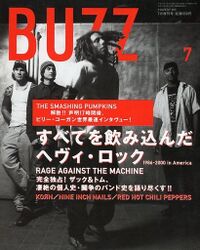BUZZ (July 2000)

An interview with Hirohiko Araki found in the July 2000 issue of the BUZZ magazine (Vol. 21).
Interview
たまには音楽畑以外にも、いろんな人に会って、いろんな話を聞いてみたい。だって、僕らは生きてるんだもん! というわけで今回から始まった新コーナー。第1回目は漫画家の荒木飛呂彦先生です。
おそらくロック・ファンには既におなじみであろう『ジョジョの奇妙な冒険』。何世代にも亙る数奇な運命と血の物語を、緻密な構成と筆力で描き出す少年ジャンプ連載の傑作カルト漫画である。さらに登場人物が次々と繰り出す異能力=「スタンド」に、ロックの名作や偉人の名前がガンガン出てくるのも人気の的。「レッド・ホット・チリ・ペッパー!」「スティッキィ・フィンガーズ!」「セックス・ピストルズ!」という雄叫びと共に発現する奇怪なフォルムの能力達。現在シリーズ第6部「ストーンオーシャン」での新展開を見せている『ジョジョ』ですが、大のロック・ファンである荒木先生にその作家性の根拠と、今回の特集にちなんだ「あなたにとってのヘヴィ・ロックの名盤5枚は?」を尋ねに会ってきました。
●今日は荒木さんの奇妙な作風がどのように生まれたかというのをお聞きしたいなと。
「どういう感じかなあ。梶原一騎のスポーツ根性――『巨人の星』とか『柔道一直線』の主人公がどんどん成長していくストーリー、それが子供ん時に凄い好きだったですね。と同時に横山光輝と白土三平の忍者マンガというのがあって。白土三平だと『カムイ外伝』とか。横山光輝は『仮面の忍者赤影』『バビル2世』とか。その2つが好きだったんですけど、梶原一騎の方は主人公がどんどん成長していくタイプのストーリーっていう。横山光輝タイプの作品というのはサスペンスとトリックっていうか。子供ながらにも、『こういう2つのタイプみたいなのがあるんだな』みたいなね」
●漫画好きの内向的な少年だったんですか。
「いや、普通です。私は剣道やってたんですけど、試合が凄いヤで。もう相手の気迫みたいなのが嫌なんですよ」 ●じゃあ何で剣道やってたんですか。
「なんか、『おれは鉄兵』読んでて」
●ははははは!
「自己鍛錬ですね。自分の成長の為に試合してるっていう感じで、自分は闘いを描いてるんですけども。弱かった自分がね、相手に勝つっていうよりも己に勝つ為に戦うっていう。あと闘う時も、根性とかで勝つのはね、あんまり自分は嫌なんですよ。やっぱりワンランク精神がアップして、それを手に入れて倒すとかね」 ●「スタンド」って発想もそういう事だと。
「そうです。今まで念力っていうと『うん』って念じてバカッて石が割れたりするんだけど、守護霊みたいなのが後ろから出てきて、本当は見えない心が出てきてそれを割るっていう、そういう発想なんですよ」
●僕は最初『ジョジョ』読んだ時「面白いけど変な漫画だなあ」と思って。アンケートの結果にシビアであるとされてるジャンプだったら、あと何回で終わっちゃうんだろうと思って読んでたとこあったんですよ。
「そうですねえ。その辺もギリギリのところでやってたかもしんないですね。でもとにかく描きたい事はいっぱいあったから、自分では終わる気全然ないですよ。やっぱり善の象徴と悪の象徴の闘い・・・その精神性ですね。1話目の辺りはちょっと肉体的なんですよ。当時シュワルツネッガーとかスタローンとか、映画でマッチョな男が出てきて闘う話が大ヒットするんで、それにあやかったのか何だか自分もその方向に行ってたんですけど、やっぱりその精神性みたいなのが頭にもたげてきまして、第3部のような感じになったんですけど。だから最初はマッチョの肉体を追及してたんですよ。肉体の極限ていうか『どこまで人間は肉体的にいけるか』みたいなね。それが精神性になった時にかなり広がってったっていうか。で、第3部の空条承太郎の時に苦労したのは――ディオっていう敵が最後にいるんですけど、そのディオを見せるとね、読者は空条承太郎対ディオの闘いを期待しちゃうわけですよ。その間どうでもいいわけ、その手下は。だからディオをなるべくとにかく出さないっていう。あれはかなり苦労したんですよ。いろんなマンガ見てても――ラオウが出るともうラオウなんですよ」
●はははは。
「ケンシロウ対ラオウで。その間に出てくる敵はね、あんま興味ないわけ。だから出しちゃダメなんだなと思って。私はむしろ道中記を描きたいのに、それなのに最後の敵を出しちゃうんじゃもうとにかくダメ。ダメっていうか、ストーリーはかなり苦しくなるっていうのは思いましたけどね。あとトーナメント式にしなかったっていうのかな。どんどん上に上がってくってタイプにしないで、すごろく的な――水戸黄門的な『ここではこの敵、ここではこの敵』っていう。で、強さは関係ないっていうか」
●強さは関係ない?
「キャラクターなんですよ。敵の強さで描くと、前より強くなきゃいけないんですよ。そうするとバブリーな話じゃないですか。最初の敵より強い敵、強い敵って、最後はこんな膨らんじゃって収拾つかなくなるんで。強いキャラクターもあれば、ちょっと弱めでずる賢い奴もいて。まあそれにスタンドっていうアイデアがハマったっていうところがあるんじゃないですかね」
●スタンドのネーミングとは別に、作品そのものに自分のロック観っていうのが影響与えてるなあって気はします?
「あのねえ、マンガを読むテンポってあるんですよ。ページをめくってトントントントントンみたいな。リズムっていうのが。そういうのがロックのリズムで。だからトトトトトトトトトトンッとかね。ドドドドドドバコッとかね。ゴゴゴゴゴゴゴゴドーンとかね。バキューン!とかね」
●ははははは。
「あとはまあミュージシャンの伝記とか読んで、『この人はこういう事考えてんのか』っていうのがキャラクターに反映されてたりするのはあるかもしんないですけど。ジミ・ヘンドリックスとかね。ロックじゃないけどモーツァルトとか
●そう言えば、荒木先生の描くキャラクターって何となくみんな悲しげですよね。ハッピーなキャラっていうのは――。 「あんまないかもね。やっぱそれじゃないと面白くないんですかね。編集者でね、『生きてるのがつらくなるような作品読みてえよな』とか言った人がいてね。例えば、スティーヴン・キングっていうキャラクターっていうのは、なんか生きてるだけでその存在が悲しいやないかみたいな。その人がそこにいるだけで悲しいんですよ」 ●そういう影とか悲しさとかを必ず抱えてるキャラクターを描いてると同時に、少年の成長みたいなのを前提にしてると。じゃあ成長していきながらも、最終的なハッピーにはならないのかな、みたいな。
「うーん、でもまあ一応何かを掴んでると思いますけどね。あんまり不幸になって終わってるっていうのはないと思いますけども。一応これからも課題を抱えながらも、一つの敵はクリアしていくんだろうなっていう、そういう感じですね。でも物悲しい感じは絶対いいですね。音楽もそうですけども。『切ないなあ』みたいな」
●実は荒木さんの作品って、いたるところにユーモアがあるじゃないですか。あんまりそういう笑いの点って指摘されてないんじゃないかなと思うんですけど。
「ギャグっていうか、あれはヘヴィになり過ぎないようにっていうのもありますよね。描いててつらくなる時があるんですよ。読者もつらくなるとヤなんじゃないかなとか思って。だからそういうつらいののちょっと裏を返すっていうのかな。ブラックなユーモアとかで、本当はヤバい事なんだけど、ブラックな味つけにする事によって、ちょっと救いがあるっていうんですか。例えば具体的に言うと、この前のジョルノっていう主人公の時の作品で、1人仲間が消えるんですよ、途中で。それね、最初仲間を裏切って逃げるっていう考えだったんですよ。だけどいざ描こうとしたら、凄いヤバいと思ったんですよ。裏切るって物凄い描いててヤだなあと思ったんですよ。勇気がちょっとなかったですね。読者にも絶対これは許されねえと思ったもん。裏切りって少年誌のタブーじゃないかなと思いますね」
●それって少年誌だからって言うより、荒木さんの一貫した何かじゃないんですかね。
「うーん、でもね、悪の方にも私、感情移入してて好きなんですよ。ディオとか吉良っていう奴とかね。だからそいつの視点で描いたりしてるんですよ。悪には悪の気持ちがあるんだろうなって。だから読者もそれに感情移入するように描いたり。悪いことをするなりのね、動機っていうか」
●変な言い方ですけど、「悪を為す事においての正義感」みたいな?
「そうですね。その価値観のぶつかり合いで正義と悪に分けてますけど」
●主人公が女性って、今連載してる『ストーンオーシャン』が初めてですよね。
「女性もね、前は課題だったんですよ。やっぱりパンチとか、顔に受けられないじゃないですか、女の人って」
●そうなんですか?(笑)。
「だから今は時代が良くなったんですよ。80年代はあんな女の子出したらダメですよ。可愛い女の子じゃなきゃ漫画はダメ。どっちかって言うとロリコン系っていうのかな。だけど1人の人間として描けば、女の人も大丈夫だなあって。鼻血ぐらい出してても絵になるなって思ったんですよ」
●(笑)。
「まあ第1回目のあの辺はちょっと苦労しましたね。読者に可愛い子ちゃん路線で行くんだなっていう意識をさせないようにっていう。あえて汚い言葉使ったりとか、ちょっと肉体的な表現したりとか。可愛い子ちゃんが殴られたら、読者は『ええー!!』って思いますよ。殴られるぐらいじゃないと思うんですよね。『ジョジョ』って下手したら腕の1本も吹っ飛びますから(笑)」
●(笑)『ストーンオーシャン』は物語の展開って結構できてるんですよね。JAPANの方でお会いした時にチラッと聞いたんですが、ネタをバラすと読者に悪いからってあえて活字にはしなかったんですけど。
「(笑)もういいんじゃないですか。刑務所内だけの話になるっていう事は言いましたよね。物語は刑務所の中だけで行われます。道中もんじゃなくて、渦巻き型っていうか。中心に向かってくように」
●じゃあ最後に、今回BUZZの方でヘヴィ・ロック特集っていうのをやるんですよ。で、荒木さんのお薦めのヘヴィ・ロックの名盤5枚っていうのを――。 「ヘヴィ・ロックの概念がちょっと分かんないんですけども。レッチリもヘヴィ系に入るんですか」
●今回ウチの雑誌ではそういう事にしました(笑)。
「まずレイジの『イーヴィル・エンパイア』が入ってますね。あとリンプ・ビズキットの『シグニフィカント・アザー』。あとこれが私のNo.1なんですけど、バックチェリーの1枚目。ジャケットがいいんですよ。あとメタリカの『S&M』を入れとこうかな。最新ライヴですね。で、ボストンの『ウォーク・オン』」
●ボストン(笑)。ヘヴィ・ロックとして?
「ヘヴィ・メタじゃないの、あれ? 音はヘヴィ・ロックだけどね。あと私レッチリとか大好きですよ。あとはスキッド・ロウ、ガンズ・アンド・ローゼスでしょ。で、エアロスミスとニルヴァーナ。嫌いなのはパール・ジャムですね」
●へえ。そうなんですか。
「ハードロックってね、ちょっとエコロジカルな感じがあると思うんですよ。聴いてて気持ちいいっていうか。クラシックより全然精神的にいいと思うんですよね。強弱あんまないし。ずっとガンガンいってくれるから。で、パール・ジャムってちょっと神経に触るんですよね。音がなんかねえ」
●ふーん。面白い意見ですね。ボストンをヘヴィ・メタルと呼び、パール・ジャムの音はニルヴァーナより神経に触ると。
「ニルヴァーナは良い」